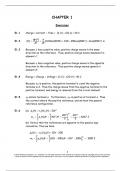CHAPTER 1
Exercises
E1.1 Charge = Current Time = (2 A) (10 s) = 20 C
dq (t ) d
E1.2 i (t ) (0.01sin(20 0t) 0.01 200cos(200 t ) 2cos(200t ) A
dt dt
E1.3 Because i2 has a positive value, positive charge moves in the same
direction as the reference. Thus, positive charge moves downward in
element C.
Because i3 has a negative value, positive charge moves in the opposite
direction to the reference. Thus positive charge moves upward in
element E.
E1.4 Energy = Charge Voltage = (2 C) (20 V) = 40 J
Because vab is positive, the positive terminal is a and the negative
terminal is b. Thus the charge moves from the negative terminal to the
positive terminal, and energy is removed from the circuit element.
E1.5 iab enters terminal a. Furthermore, vab is positive at terminal a. Thus
the current enters the positive reference, and we have the passive
reference configuration.
E1.6 (a) pa (t ) v a (t )ia (t ) 20t 2
10 10 10
20t 3 20t 3
w a pa (t )dt 20t dt 2
6667 J
0 0
3 0
3
(b) Notice that the references are opposite to the passive sign
convention. Thus we have:
pb (t ) v b (t )ib (t ) 20t 200
10 10
10
w b pb (t )dt (20t 200 )dt 10t 2 200t 0
1000 J
0 0
1
© 2018 Pearson Education, Inc., Hoboken, NJ. All rights reserved. This material is protected under all copyright laws as they currently
exist. No portion of this material may be reproduced, in any form or by any means, without permission in writing from the publisher.
,E1.7 (a) Sum of currents leaving = Sum of currents entering
ia = 1 + 3 = 4 A
(b) 2 = 1 + 3 + ib ib = -2 A
(c) 0 = 1 + ic + 4 + 3 ic = -8 A
E1.8 Elements A and B are in series. Also, elements E, F, and G are in series.
E1.9 Go clockwise around the loop consisting of elements A, B, and C:
-3 - 5 +vc = 0 vc = 8 V
Then go clockwise around the loop composed of elements C, D and E:
- vc - (-10) + ve = 0 ve = -2 V
E1.10 Elements E and F are in parallel; elements A and B are in series.
ρL
E1.11 The resistance of a wire is given by R . Using A d and
A
substituting values, we have:
1.12 10 6 L
9.6 L = 17.2 m
(1.6 10 3 )
E1.12 P V 2 R R V 2 / P 144 I V / R 0.833 A
E1.13 P V 2 R V PR 0.25 1000 15.8 V
I V / R 15. 15.8 mA
E1.14 Using KCL at the top node of the circuit, we have i1 = i2. Then, using KVL
going clockwise, we have -v1 - v2 = 0; but v1 = 25 V, so we have v2 = -25 V.
Next we have i1 = i2 = v2/R = -1 A. Finally, we have
PR v 2i2 (25) (1) 25 W and Ps v 1i1 (25) (1) 25 W.
E1.15 At the top node we have iR = is = 2A. By Ohm’s law we have vR = RiR = 80
V. By KVL we have vs = vR = 80 V. Then ps = -vsis = -160 W (the minus sign
is due to the fact that the references for vs and is are opposite to the
passive sign configuration). Also we have PR v R iR 160 W.
2
© 2018 Pearson Education, Inc., Hoboken, NJ. All rights reserved. This material is protected under all copyright laws as they currently
exist. No portion of this material may be reproduced, in any form or by any means, without permission in writing from the publisher.
, Problems
P1.1 Broadly, the two objectives of electrical systems are:
1. To gather, store, process, transport and present information.
2. To distribute, store, and convert energy between various forms.
P1.2 Four reasons that non-electrical engineering majors need to learn the
fundamentals of EE are:
1. To pass the Fundamentals of Engineering Exam.
2. To be able to lead in the design of systems that contain
electrical/electronic elements.
3. To be able to operate and maintain systems that contain
electrical/electronic functional blocks.
4. To be able to communicate effectively with electrical engineers.
P1.3 Eight subdivisions of EE are:
1. Communication systems.
2. Computer systems.
3. Control systems.
4. Electromagnetics.
5. Electronics.
6. Photonics.
7. Power systems.
8. Signal Processing.
P1.4 Responses to this question are varied.
P1.5 (a) Electrical current is the time rate of flow of net charge through a
conductor or circuit element. Its units are amperes, which are equivalent
to coulombs per second.
(b) The voltage between two points in a circuit is the amount of energy
transferred per unit of charge moving between the points. Voltage has
units of volts, which are equivalent to joules per coulomb.
3
© 2018 Pearson Education, Inc., Hoboken, NJ. All rights reserved. This material is protected under all copyright laws as they currently
exist. No portion of this material may be reproduced, in any form or by any means, without permission in writing from the publisher.




